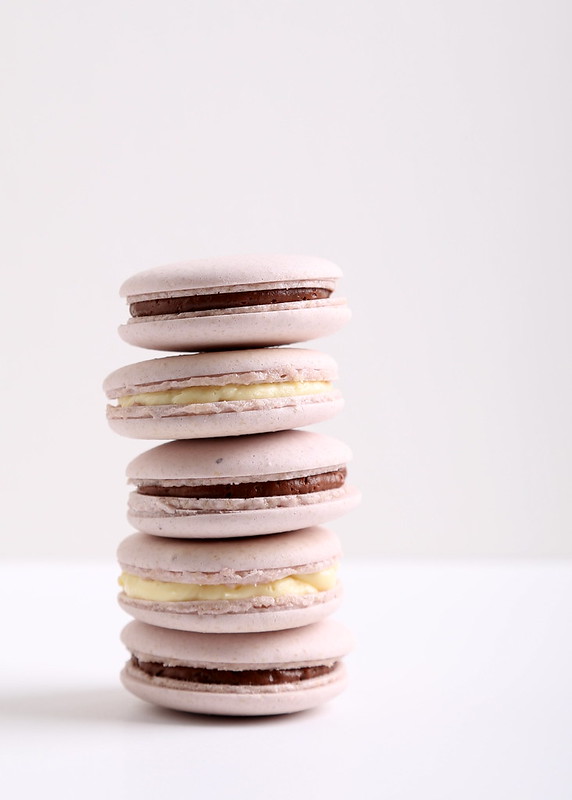Basic vegan macarons have four ingredients: chickpea brine (aquafaba), almond meal, caster sugar and powdered sugar. How hard can something with so few ingredients be to make?
Actually very hard!
Well, at least for me. I’m no baker and I’d rather just buy a dessert instead of trying to make it myself. However, I wanted to try them out of complete curiosity after seeing a basic macaron recipe from the lovely Charis over at Floral Frosting. After three failures in a row that had nothing to do with the recipe, but my complete inexperience with macaron-making, I got a bit obsessed with trying to make them correctly myself. Here’s what I learned from making multiple batches:
MEASURE. If you have one little ratio off with any ingredient, your macarons will not turn out correctly.
The MACRONNAGE. If you undermix or overmix the batter, your macarons may be too thin, too thick, collapse in the oven or not develop feet. See the 1:26 mark on Floral Frosting’s macaron video on how to do the macronnage correctly.
SMACK the piped macarons on the counter to release any air bubbles. Don’t be shy with smacking them and don’t skip this step or your macarons will turn into a mess in the oven.
DRY the piped macarons for two hours or until the tops are dry. If your house has any humidity, your macarons will not develop feet. Run your air conditioning for several hours before and during making macarons, or only make them when the air is cold and the humidity is low. I learned this the hard way!
The reason you want the tops dry is that the heat causes the air inside the batter to expand, pushing it upwards. Dry tops are stronger tops that aid in forming feet. Not-dry tops will result in the batter squishing through the tops, destroying your chance of getting pretty-shaped macarons.
Lots of instructions will tell you to turn the batter 10, 20 even 50 times, but I found that turning the batter until it fell back into the bowl when lifted with the spatula and settled immediately worked better than counting. It took several batches to “get” how this should look.
BAKING: Our oven is kind of possessed. It preheats very slowly, then jacks up very quickly, and the heat isn’t quite even. But we have a thermometer which helps with predicting the oven’s behavior/current mood.
I first tried putting the piped macarons in a cold oven and bringing them up to 225 degrees, putting them into a preheated 225-degree oven, turning off the heat, venting the oven and leaving them inside until the oven was cool again.
What I discovered is that using a pizza stone lined with parchment paper in a cold oven first worked best. However! All ovens are different, and what may be successful in one oven may not work in another.
In all, making macarons was a fun, but sometimes frustrating, experience. Watching your macarons get feet for the first time is totally worth all the work.
Once your macarons are baked and cooled, they store well in the refrigerator or freezer.
So that’s it! I won’t be baking or doing any technical desserts for a while now, but this was a fun project to figure out and tackle. Check out the Vegan Meringue – Hits and Misses! Page on Facebook for more tips on vegan+aquafaba macarons from some really amazing and experienced vegan bakers. Enjoy!










Wow, 60% is a lot! Baking macarons takes a lot patience in California! Thanks for sharing the exact percentage 🙂
Well, I like the humidity here whenever it's not winter… In our new appartment the humidity plummets to under 20% (and that is really irritating for eyes and skin, we just had to buy humidifier to stop the irratation!), so yeah, it is perfect for macaron baking, but not living in general.
But even though the air is drier here, to make good macarons we have to get all the other stuff right, like the measuring and the macaronnage and they're not so easy – I've failed often before getting them right 🙂
Thanks for this blog, it's excellent!
We live in Southern California — the humidity right now is at about 60%, which was probably a bit higher when I was experimenting in June/July. Some of the batches took even longer than two hours to dry, but I am not sure I can blame the humidity completely on that. (some of the batters were just more "wet" to begin with) All the more reason to measure correctly each time!
Your low humidity sounds wonderful!
Hi! I would really like to hear what is the exact humidity in your kitchen or house, do you happen to have any idea? I am interested in this because I live in Finland, and here the houses have been built so that in the spring, summer and fall we have 30-40% relative humidity and during winter even lower. When I make maracons in the spring, summer or fall, about 30min of drying them is enough and in the winter they dry faster. So when I read your post I was like "whaaat, the drying cannot take several hours?!", but then I remembered that not all houses are built like this 🙂
Thanks for sharing your experience. I tried macarons once so far after Charis first posted her video tutorial. It was a failure, and I've been very scared to try again. I think it was the macronnage stage that I either overdid or underdid (truly not sure which)–you giving the tip of the batter's behavior might help me more than trying to figure out what the *correct* number of strokes is. Still not sure I'll try again soon, but maybe 🙂
I think I may have made over 12 batches! Worth it, though, to see progress. I hope you try it again with success!